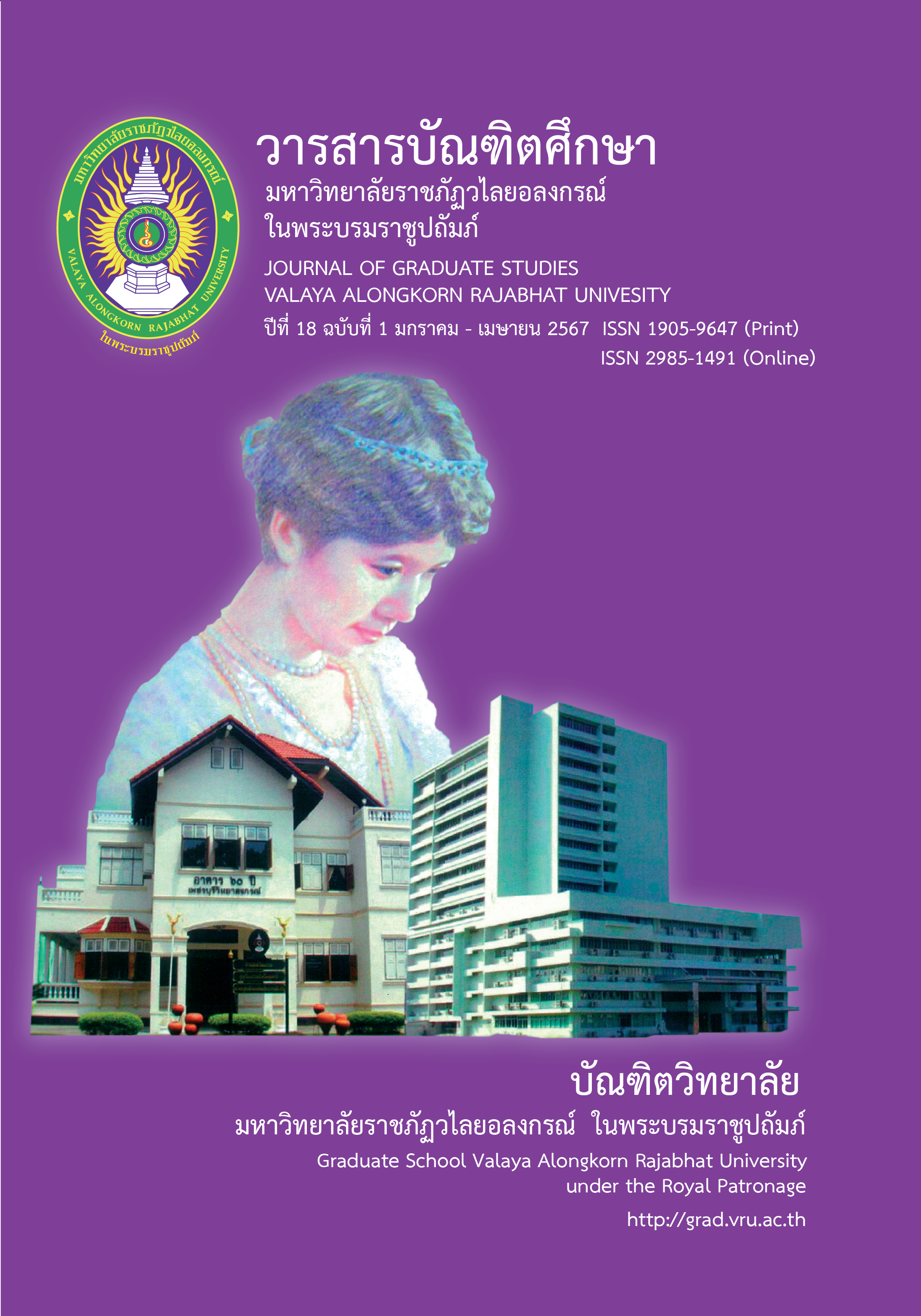โมเดลสมการโครงสร้างของพฤติกรรมการสื่อสารภายในองค์กรผ่านสื่อสังคมออนไลน์ ของบุคลากรสายสนับสนุนมหาวิทยาลัยราชภัฏในเขตกรุงเทพมหานคร
Main Article Content
บทคัดย่อ
การวิจัยครั้งนี้มีวัตถุประสงค์เพื่อ 1) พัฒนาโมเดลสมการโครงสร้างของพฤติกรรมการสื่อสารภายในองค์กรผ่านสื่อสังคมออนไลน์ของบุคลากรสายสนับสนุนมหาวิทยาลัยราชภัฏในเขตกรุงเทพมหานคร และ 2) ตรวจสอบความสอดคล้องของโมเดลสมการโครงสร้างของพฤติกรรมการสื่อสารภายในองค์กรผ่านสื่อสังคมออนไลน์ของบุคลากรสายสนับสนุนมหาวิทยาลัยราชภัฏในเขตกรุงเทพมหานครกับข้อมูลเชิงประจักษ์ วิธีดำเนินการวิจัยโดยเก็บรวบรวมข้อมูลด้วยแบบสอบถามกับบุคลากรสายสนับสนุนมหาวิทยาลัยราชภัฏในเขตกรุงเทพมหานคร จำนวน 380 คน วิเคราะห์ข้อมูลด้วยสถิติเชิงบรรยาย การวิเคราะห์องค์ประกอบ การวิเคราะห์สัมประสิทธิ์สหสัมพันธ์แบบเพียร์สันและการวิเคราะห์โมเดลสมการโครงสร้าง
ผลการวิจัยพบว่า 1) ปัจจัยที่ส่งผลต่อพฤติกรรมการสื่อสารภายในองค์กรผ่านสื่อสังคมออนไลน์มี 3 ตัวแปร ได้แก่ พฤติกรรมความตั้งใจในการใช้งาน สภาพสิ่งอำนวยความสะดวกในการใช้งาน และความเคยชิน และ 2) โมเดลสมการโครงสร้างสอดคล้องกับข้อมูลเชิงประจักษ์ โดยพิจารณาค่าไคสแควร์ เท่ากับ 355.62 ค่าไค-สแควร์สัมพัทธ์ เท่ากับ 1.342 ค่าระดับความน่าจะเป็น (p) เท่ากับ 0.347 ค่าดัชนีระดับความกลมกลืน (GFI) เท่ากับ 0.988 ค่าดัชนีระดับความกลมกลืนที่ปรับแก้แล้ว (AGFI) เท่ากับ 0.967 และค่าดัชนีรากที่สองของค่าเฉลี่ยของส่วนเหลือคลาดเคลื่อนกำลังสองของการประมาณค่า (RMSEA) มีค่าเท่ากับ 0.012
Article Details

อนุญาตภายใต้เงื่อนไข Creative Commons Attribution-NonCommercial-NoDerivatives 4.0 International License.
บทความทุกเรื่องได้รับการตรวจความถูกต้องทางวิชาการโดยผู้ทรงคุณวุฒิ ทรรศนะและข้อคิดเห็นในบทความ Journal of Global of Perspectives in Humanities and Social Sciences (J-GPHSS) มิใช่เป็นทรรศนะและความคิดของผู้จัดทำจึงมิใช่ความรับผิดชอบของบัณฑิตวิทยาลัย มหาวิทยาลัยราชภัฏวไลยอลงกรณ์ ในพระบรมราชูปถัมภ์ กองบรรณาธิการไม่สงวนสิทธิ์การคัดลอก แต่ให้อ้างอิงแหล่งที่มา
เอกสารอ้างอิง
AbuShanab, E. & Pearson, J. M. (2007). Internet banking in Jordan: The unified theory of acceptance and use of technology (UTAUT) perspective. Journal of Systems and Information Technology. 9(1), 78-97.
Ajzen, I. (2012). The theory of planned behavior. In Lange, P. A. M., Kruglanski, A. W. & Higgins, E. T. (Eds.), Handbook of theories of social psychology. London: Sage.
Hair, J. F., Anderson, R. E., Tatham, R. L. & Black, W. C. (1995). Multivariate data analysis. Englewood Cliffs, NJ Prentice-Hall.
Leong, L. Y., Hew, T. S., Tan, G. W. H. & Ooi, K. B. (2013). Predicting the determinants of the NFC-enabled mobile credit card acceptance: A neural networks approach. Expert Systems with Applications. 40, 5604-5620.
Liao, C., Palvia, P. & Lin, H. N. (2016). The roles of habit and web site quality in e-commerce. Journal of Information Management. 26, 469-483.
Mafe, C. R., Blas, S. S. & Tavera-Mesias, J. F. (2010). A comparative study of mobile messaging services acceptance to participate in television programmes. Journal of Service Management. 21(1), 69-102.
Ounruang, S. (2017). rūpbǣp khwāmsamphan chœ̄ng sāhēt khō̜ng kānyō̜mrap læ kānchai theknōlōyī thī mī phon tō̜ phrưttikam kānchai ʻǣp phlikhēchan chō̜pping bon samātfōn khō̜ng prachākō̜n nai khēt Krung Thēp Mahā Nakhō̜n læ parimonthon [A Causal Relationship Model of Adoption and the use of Technology that Affect Behaviors for the Shopping Applications on Smart Phones of the Population in Bangkok and its Vicinity]. In kān prachum wichākān sanœ̄ phon ngānwičhai radap bandit sưksā hǣng chāt khrang thī yīsipsō̜ng [Proceeding of Conference: The 22nd National Graduate Research Conference, 201-210]. Khon Kaen: Khon Kaen University.
Office of the Higher Education Commission. (2020). khō̜mūn sathiti [Statistical Data]. Retrieved from http://www.info.mua.go.th/information/
Pahnila, S., Siponen, M. & Zheng, X. (2011). Integrating habit into UTAUT: The Chinese eBay case. Journal of the Association for Information Systems. 3(2), 1-30.
Prapakornkiat, T. (2017). rūpbǣp khwāmsamphan chœ̄ng sāhēt khō̜ng kānyō̜mrap læ kānchai theknōlōyī thī mī phon tō̜ phrưttikam kānchai bō̜rikān rap – song phatsadu phān ʻǣp phlikhēchan Airpay khō̜ng prachākō̜n nai khēt Krung Thēp Mahā Nakhō̜n læ parimonthon [Causal Relationship Model of Theory Acceptance Process of Technology on Behavior of the Parcel Delivery Through AIRPAY Application of Population in Bangkok and its Vicinities]. In kān prachum: kān prachum khrư̄akhāi naksưksā bandit sangkhomwitthayā læ mānutsayawitthayā hǣng prathēt Thai khrang thī siphok [Proceeding of Conference: The 16th Conference of Thailand’s Sociology and Anthropology Graduate Student Network], Grande Centre Point Hotel, Pattaya.
Saraphat, A. (2017). rūpbǣp khwāmsamphan chœ̄ng sāhēt khō̜ng kānyō̜mrap læ kānchai theknōlōyī thī mī tō̜ phrưttikamkān sư̄sān phāinai ʻongkō̜n phān sư̄ sangkhom ʻō̜nlai khō̜ng bukkhalākō̜n rōngrīan trīam thahān [A Causal Relationship Model of Extended Unified Theory of Acceptance and use of Technology Affecting Officers in the Armed Forces Academies Preparatory School’s Internal Communication Behavior via Social Media Application]. Master of Business Administration Thesis Rangsit University.
Sukyanee, O. (2015). khwāmtangčhai nai kānchai rabop sārasonthēt kānbō̜rihān sapphayākō̜n bukkhon khō̜ng bukkhalākō̜n sathāban bandit phatthana bō̜rihān sāt: kānprayukchai tūa bǣp kānyō̜mrap theknōlōyī [Intention to use Human Resource Management Information System of National Institute of Development Administration: Application of Technology Acceptance Model]. Research Report. National Institute of Development Administration.
Sun, Q., Cao, H. & You, J. (2010). Factors influencing the adoption of mobile service in China: An integration of TAM. Journal of Computers. 5(5), 799-806.
Venkatesh, V., Thong, J. Y. L. & Xu, X. (2012). Consumer acceptance and use of information technology: Extending the unified theory of acceptance and use of technology. MIS Quarterly. 36(1), 157-178.
Wanprapha, T. (2017). sư̄ sangkhom ʻō̜nlai kap kānsưksā [social media with education]. Journal of Education Mahasarakhan University. 11(1), 7-20.


